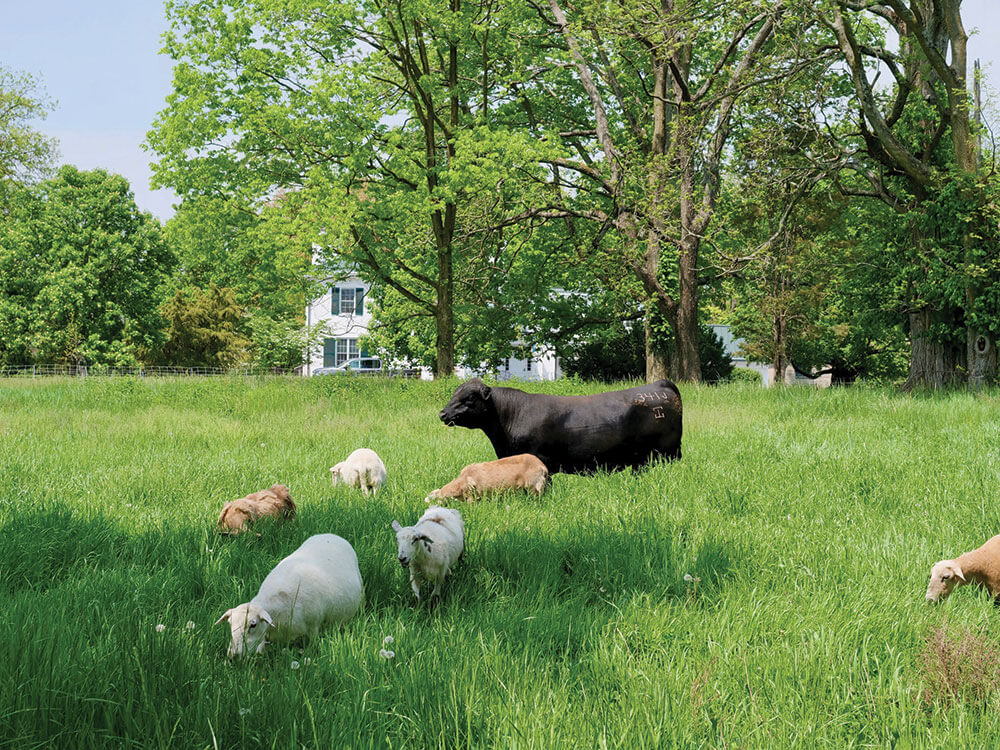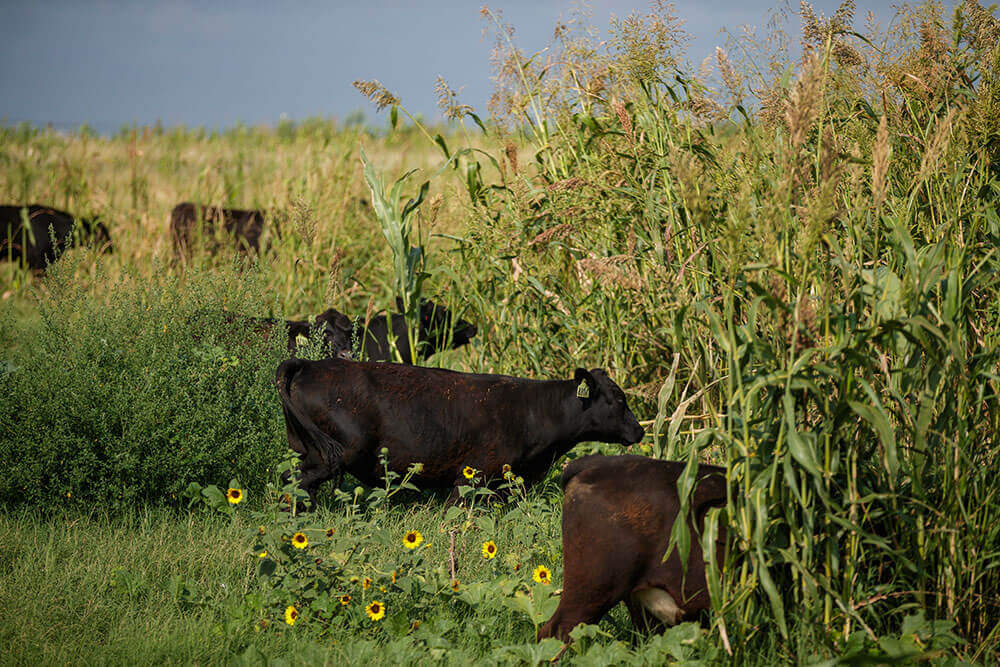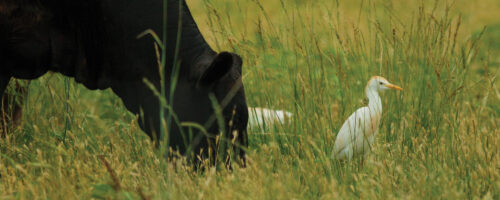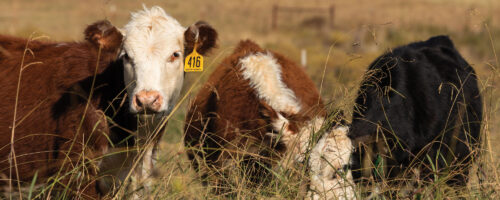Built On Solid Ground
Greenacres Foundation believes cattle and conservation go hand in hand. And it’s doing all it can to help ranchers do their best and help consumers learn about sustainable agriculture.
Greenacres Foundation is a lot of things to a lot of people:
A field trip site where tens of thousands of schoolchildren per year learn about the environment, agriculture and art in a natural setting.
- A place where English equestrians spend hours each week learning and perfecting their craft.
- A sought-after venue for some of the most high-end weddings in the Midwest.
- A supporter of musical arts.
- A farm where soil health comes first.
- A research station where data is collected on grazing lands.
But more than anything, it’s a place where agriculture is the solution, not the problem. And where they strive every day to tell that story to people from all walks of life.
Going Back To Basics
When the late Louis Nippert bought the first 47 acres of Greenacres property in 1949, it was a former corn and soybean farm near Cincinnati, Ohio … and the soil was spent.
But not for long.
Carter Randolph, Greenacres Foundation president, says the avid environmentalist had a real passion for what Nippert called “pre-1945 agriculture.”
“1945 was approximately the year when the salesman showed up with a 50-pound bag of pellets and would
tell the farmer, ‘This replaces 3 tons of that manure you’ve been spreading on your field, and it’s a lot easier,’”
Randolph explains.
Nippert wanted to restore the soils by working with nature, the way he’d witnessed the bison do out West. Of course, bison are notoriously harder to handle, so he swapped in Angus cattle while applying soil-health-building principles. Through regenerative grazing practices, he began bringing life back to the soil. As he bought more land, he continued managing it with that same mindset.
While the now-600-acre farm was operated more for pleasure than profit, Nippert and his wife, Louise, were passionate about doing things right and sharing the land and their passions with others.
In 1988, wanting to give back to the community, they started Greenacres Foundation with the intent to preserve the land for the education and enjoyment of future generations.
Values Are Everything
Their mission lives on today, and it’s carried out while upholding the “five G’s,” a series of values based closely on what was important to the Nipperts. Peter Wheeler, Greenacres Foundation’s director of marketing, says the values are how the foundation staff members ensure they are protecting and celebrating the couple’s legacy.
“They’re our driving ethos here for how we approach anything and everything,” he says. “It all starts with the five G’s.”
First, there’s Giving. Louis and Louise Nippert were giving people. Greenacres is a gift from the Nipperts to the
communities.
“Greenacres employees should always be giving of ourselves, to each other and the communities we serve,” Wheeler says. “The first G is really saying that we’re using our resources to give back and provide something more than just being here.”
Next, there’s Grace. It’s the humble approach to life and the way the staff implements the mission.
“Each guest is made to feel special, and the staff strives to make their visit memorable — just like we know through stories passed down that Louis and Louise always did,” Wheeler says.
The third G, Green, means always looking at the big picture, thinking holistically and considering all direct and indirect consequences of a decision on Greenacres, its guests and the environment.
The Good Neighbor Policy is the fourth G, but Wheeler says there’s more to it than the usual definition.
“Some people assume that just means we won’t upset our neighbors,” he says. “That literal definition is important, but there’s a lot more to it. We share our assets; we share our data; we’re being mindful of organizations we work with.”
And, finally, there’s Generative, the foundation’s take on regenerative
agriculture.
“If a lizard drops its tail, it tries to regenerate that tail to what it once was,” says Chad Bitler, director of research at Greenacres Foundation and one of the founding collaborators of Metrics, Management, and Monitoring: An Investigation of Pasture and Rangeland Soil Health and its Drivers. “We use the term generative here because no matter what, we’re just trying to improve every year, in every way.”
Bitler says no matter what you call it – regenerative or generative – Greenacres Foundation and Noble Research Institute are on the same page. Everything boils down to the far-reaching impact that soil health has on producer profitability and everyone’s well-being.

Big Isn’t Bad
Outside of participating in and helping fund Metrics, Management, and Monitoring: An Investigation of Pasture and Rangeland Soil Health and its Drivers, Greenacres Foundation is leading or partnering on several additional research projects.
“When we look at regenerative agriculture, we look at it holistically,” Bitler says. “But I would say our niche is looking at ‘how do regenerative practices benefit human health?’”
He says they’re particularly interested in how management practices on the ranch could impact the nutritional quality of grass-fed and grass-finished beef.
Bitler uses a Greenacres Foundation project with Utah State University as another example. This project will bring all this into context for the consumer, and eventually help ranchers who focus on soil health get paid for their stewardship.
“We think it could really help move the needle for regeneratively raised products, because ultimately the consumer is going to decide what the practices are going to be by voting with their dollar,” he says.
He explains if consumers demand it, then the larger meat conglomerates will begin to ask that their producers start following some of these practices.
Bitler knows multi-national corporations can be frowned upon, both by environmentally minded consumers and producers alike. But he says it’s important to recognize how their size can be used for good.
“You have to think beyond the corporation. It’s the people working for them,” he explains. “And every corporation has good people who are trying to move the needle in this direction.”
He cites McDonald’s as a prime example.
“The guy who hired me later went to work as the director of sustainability at McDonald’s,” Bitler says. “I said to him one day, ‘It’s kind of striking that you would go from here to McDonald’s, from one end of the spectrum to another.’”
His comeback really stuck with Bitler.
“He told me, ‘While you guys are doing great things at Greenacres, you’re raising 1,500 chickens a year. McDonald’s is buying a million chickens a day,’” Bitler says. “The thing is, if someone is actually going to move the needle and reward producers for their management practices, it’s going to take a McDonald’s or a JBS or a Tyson.”
After all, farmers and ranchers have to sell their product somewhere, and not everyone wants to, or is set up to, sell direct-to-consumer.
And just like Noble Research Institute, with whom Bitler says they’re proud to partner, Greenacres Foundation exists to help producers.
“Just like Noble is a resource, we’re a resource too,” he says. “Our context may be different, but ultimately, we’re trying to not just tell a story, but tell a story with supportive data. You can talk until you’re blue in the face to a lot of people, and they want evidence that it works, not just be told it works. That’s why we’re here.”

Noble, Greenacres and 9 other organizations and universities are in year two of Metrics, Management, and Monitoring: An Investigation of Pasture and Rangeland Soil Health and its Drivers.



Comment